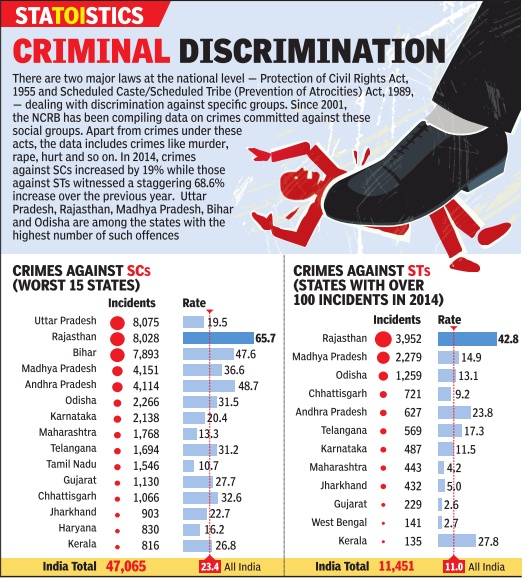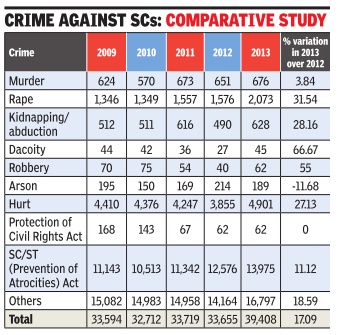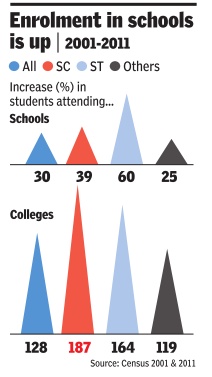Scheduled Castes: status, issues (post-1947)
(→Crimes against SCs) |
(→SC certificates for Christians) |
||
| Line 18: | Line 18: | ||
Scheduled castes | Scheduled castes | ||
| − | = SC certificates for | + | =Christians, SC certificates for= |
''' Church-going dalit cannot be denied SC certificates: HC ''' | ''' Church-going dalit cannot be denied SC certificates: HC ''' | ||
| Line 33: | Line 33: | ||
The report merely stated that the Jayaraj was often visiting the church in Othiyampattu village. | The report merely stated that the Jayaraj was often visiting the church in Othiyampattu village. | ||
| − | The judges said the sub-collector was bound to conduct a proper inquiry and could take a decision only after affording opportunity of hearing to the applicant. Pointing out that such a procedure had not been followed in the present case, they set aside the impugned order dated June 21, 2011. The court also restored the application of Jayaraj and asked the officials to consider the matter afresh and pass fresh orders within four weeks. | + | The judges said the sub-collector was bound to conduct a proper inquiry and could take a decision only after affording opportunity of hearing to the applicant. Pointing out that such a procedure had not been followed in the present case, they set aside the impugned order dated June 21, 2011. The court also restored the application of Jayaraj and asked the officials to consider the matter afresh and pass fresh orders within four weeks. |
= Crimes against the Scheduled Castes/ Dalits= | = Crimes against the Scheduled Castes/ Dalits= | ||
Revision as of 13:54, 31 August 2016

This is a collection of articles archived for the excellence of their content. Readers will be able to edit existing articles and post new articles directly |
Scheduled castes
Contents |
Christians, SC certificates for
Church-going dalit cannot be denied SC certificates: HC
A Subramani,TNN | Dec 27, 2013
CHENNAI: There is no rationale in denying scheduled caste (SC) certificate and other benefits to a church-going dalit, the Madras high court has said.
A division bench comprising Justice N Paul Vasanthakumar and Justice T S Sivagnanam, passing orders on a person whose application for SC certificate was rejected by a sub-collector in Puducherry, said going to church could seldom be considered a valid reason to reject the application.
"For deciding the community status, the factors that are to be verified are whether the person is suffering from any kind of social and economic disability and whether the scheduled caste Hindus in the locality are treating the person as one among themselves," they said.
Noting that the sub-collector got carried away by the VAO's report and rejected M Jayaraj alias Ramajayam's claim, the judges said: "Rejection of community/social status community certificate to deserving person will deny his valuable rights guaranteed under the Constitution and attaches civil consequences."
The report merely stated that the Jayaraj was often visiting the church in Othiyampattu village.
The judges said the sub-collector was bound to conduct a proper inquiry and could take a decision only after affording opportunity of hearing to the applicant. Pointing out that such a procedure had not been followed in the present case, they set aside the impugned order dated June 21, 2011. The court also restored the application of Jayaraj and asked the officials to consider the matter afresh and pass fresh orders within four weeks.
Crimes against the Scheduled Castes/ Dalits
2013, ’14: rape of SC women
Haryana: Dalit Rise Upper Castes' Envy
The Times of India, October 22, 2015
Subodh Ghildiyal
Dalit rise upper castes' envy in Haryana
Dominant Class Unable To Accept Changing Social Order In Mirchpur and Gohana, altercations between Jats and Dalits resulted in mobs razing down and burning Dalit houses, medieval style. No one died in Gohana but 50 houses were torched by a 1,000-strong mob. But Mirchpur saw a lynch mob set on fire a handicapped girl and her grandfather in their house, like Faridabad. In Sunped, Rajputs settled scores with Dalits. At the root of the brutal crimes is the newfound independence of Dalits and a questioning of the status quo. Observers say the brutal retribution inflicted by the upper castes is aimed to deliver a strong reminder to Dalits on who dominates socially . KaramvirBaudh, an activist in Haryana, said, “Jobs and small businesses are a growing trend among SCs. Cars and good houses in their neighbourhoods are visible. They refuse to work in landlords' fields.It is enough of a provocation.“ If the fault lines existed for ages, its incendiary eruption in medieval lynchings and immolations in the last decade re sults from fearless assertion by Dalits riding on job reservations and market economy . “The dominant peasant proprietors who were used to having their way are unable to take the resistance from Dalits.That is leading to brutality ,“ said Yogendra Yadav, a sociologist with roots in Haryana. The questioning of status quo is the trigger. And the op pressor changes with the turf, it could be Jats in Rohtak, Yadavs in Mahendragarh, Rajputs and OBC Rors in Yamunanagar. Dr Gulshan, who heads the Ambedkar missionaries society in Rohtak, recounted how every atrocity was accompanied by the incredulous “ek SC ne aisakardiya“ -it could refer to refusal to work in landlords' fields or challenging the harassment of a Dalit girl. “In a wrestling game, the taunt is that you lost to a Dalit boy,“ he said, talking about provocation. Sexual assault of Dalits has emerged as a new weapon to assert domination. Haryana, according to the NCRB, ranks seventh in assaults on SC women, fourth in sexual harassment, sixth in rapes.
2014
The Times of India, Oct 22 2015

Bharti Jain
Over 47k crimes against Dalits in 2014, 21 killed in Haryana: NCRB
Rahul Gandhi may claim Dalits are being increasingly targeted under NDA but National Crime Re cords Bureau statistics for the last few years of the UPA's term show crimes against scheduled castes rose almost steadily to 47,064 in 2014 from 39,408 in 2013 (a rise of 19%), 33,655 in 2012 (17%), 33,719 in 2011, 32,712 in 2010 and 33,594 in 2009.
Last year, as many as 744 Dalits were murdered, up from 676 in 2013, 651 in 2012, 673 in 2011, 570 in 2010 and 624 in 2009. Haryana, where the Congress government led by Hooda was in office till October last year, 21 people belonging to the SC community were murdered in 2014. In fact, the rate of such crimes surpassed the national average in as many as 10 states both in 2014 (23.4 per lakh of their population), and 2013 (19.57). Rate of crime against SCs means number of crimes reported against SCs per one lakh of their population.
Rapes of Dalit women stood at 2,233 in 2014, up from 2,073 in 2013, 1,576 in 2012, 1,557 in 2011, 1,349 in 2010 and 1,346 in 2009. Kidnappings and abductions too went up, barring in 2012 which saw a marginal decline. Against 755 kidnappingsabductions in 2014, there were 628 in 2013, 490 in 2012, 616 in 2011, 511 in 2010 and 512 in 2009.
2015
Neeraj Chauhan Aug 31 2016 : The Times of India (Delhi)
In the context of attacks on Dalits, the NCRB data for 2015 suggest such crimes have dipped. While 45,003 cases of crimes committed against scheduled castes were reported in 2015, the number was 47,064 in 2014, a decrease of 4.4%. Uttar Pradesh reported maximum number of attacks on Dalits -8,358, followed by Rajasthan (6,998), Bihar (6,438), Arunachal Pradesh (4,415) and Madhya Pradesh (4188). The cases included assault on Dalit women, murders, rapes and abduction.
Education
Remarkable progress, high dropout rate
The Times of India, January 24, 2016


Subodh Varma
Enrol and dropout, education is a one-way street for Dalits
The surge in education among India's most deprived communities, the dalits and adivasis, is re markable: between 2001 and 2011, the share of dalits attending college zoomed up by a staggering 187% and adivasis, by 164%. The comparable increase for all other castes put together is 119%.
So, a large number of dalits and adivasis entered colleges and universities, many of whom would have been first-generation entrants like Rohith. This is all the more remarkable considering the difficult conditions they live in 21% dalit families live in houses with thatch or bamboo roofs compared to 15% overall, 78% stay in one or two roomed houses compared to 69% overall, 35% have a drinking water source within their home compared to 47% overall, 41% do not have electricity compared to 33% overall, and 66% do not have toilets compared to 53% overall.
While school-level enrollment for all castes and communities is roughly the same, there are many more dropouts among dalits and adivasis. Among dalits, the share of school students drops from 81% in the 6-14 years age group to 60% in the 15-19 group. It plummets further to just 11% in the 20-24 age group in higher education. This fall is noticeable across communities and castes but it is the sharpest among dalits and adivasis.
According to an NSSO survey, nearly two-thirds of male dropouts from school and college said that they were needed to supplement the household income while nearly half the female dropouts said that they were needed for domestic chores. The same survey also showed that attendance rates in educational institutions were about 50% in the poorest 10% families but rose to nearly 70% in the richest 10 per cent. Poverty is thus the biggest barrier to pursuing education, and poverty levels are highest among dalits and adivasis. Besides this, these groups also face social discrimination and sometimes, abuse. At a public hearing organized by the People's Trust and CRY in Salem, Tamil Nadu, a young dalit girl, who dropped out of school, said students like her were often taunted and abused by teachers as well as students. She had started working in brick kilns or fields. Shockingly, the same atmosphere prevails in centres of higher education as incidents from various universities and the IITs show.
So, on an average, very few --about one in 10 -students at the higher levels of education are from dalit or adivasi communities. This heightens the sense of isolation among disadvantaged students. And then you have the discrimination, the high costs, the pressure to perfor m, and perhaps -as in the case of Rohith's alma mater -even official hounding.